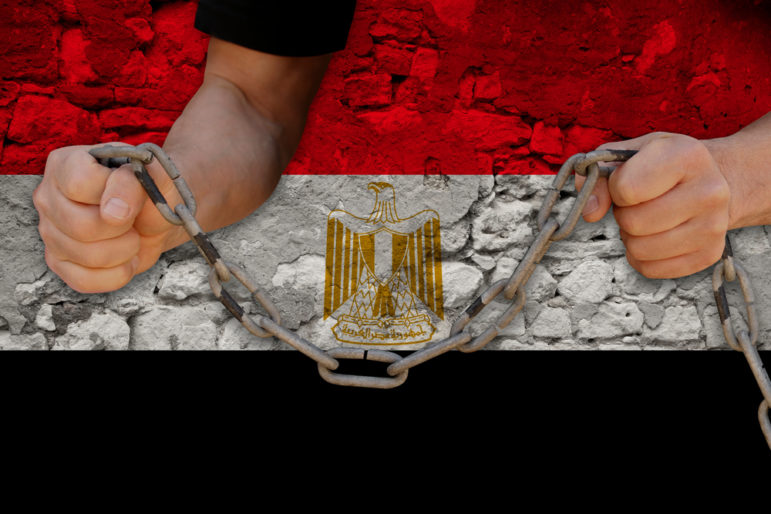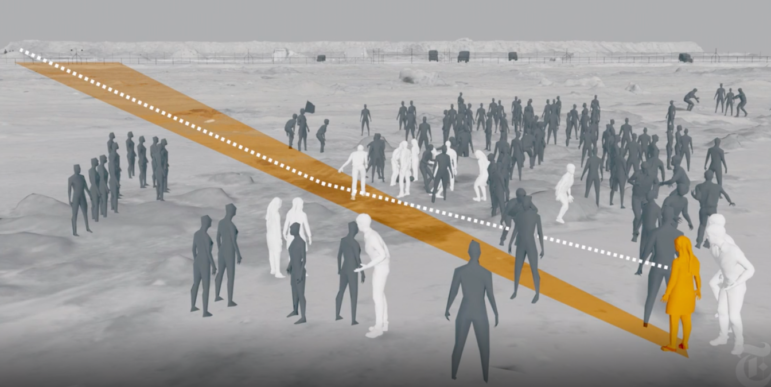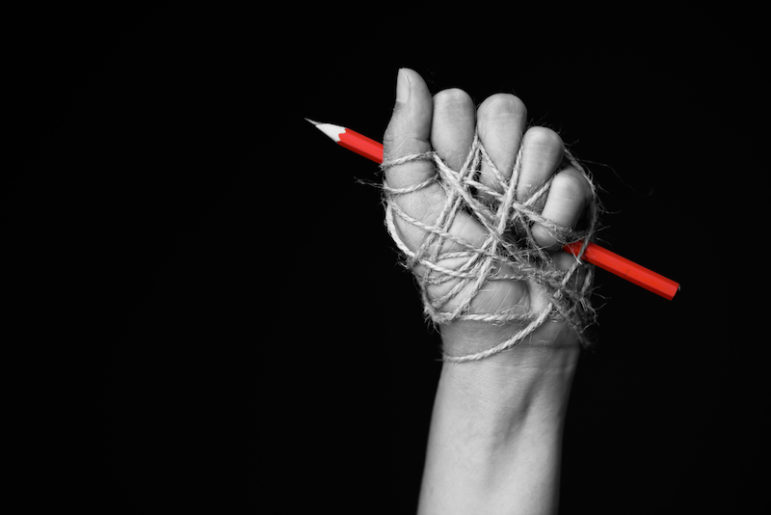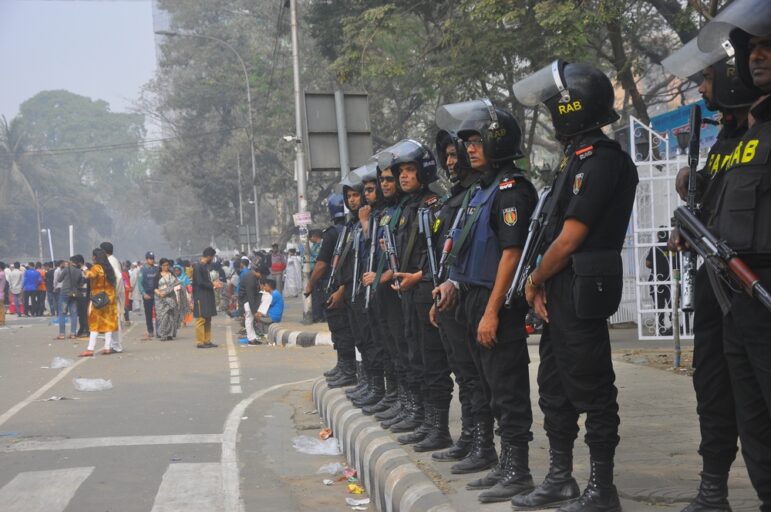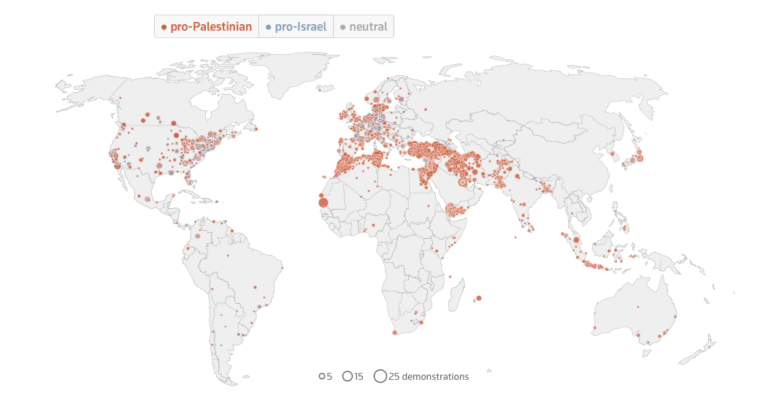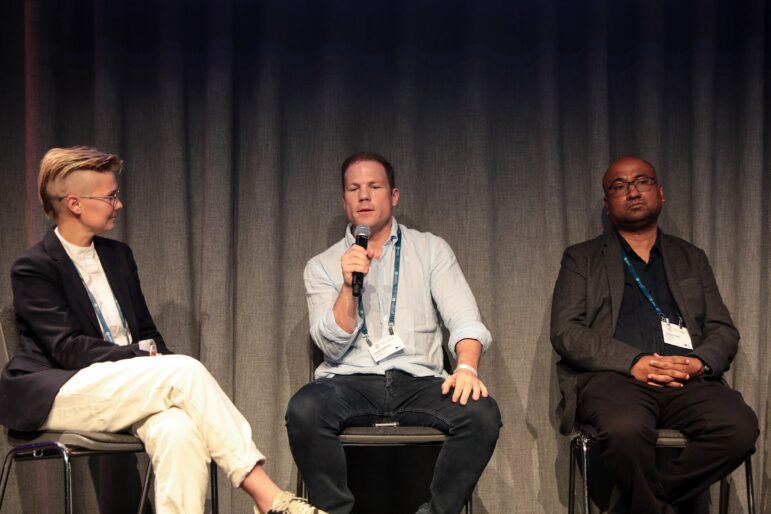

Protestors in Dhaka, Bangladesh, in early August 2024 demonstrating against quotas and the recent outbreak of police violence against students. Image: Shutterstock
Mining Social Media and Visiting Morgues to Document Police Violence in Bangladesh
Read this article in
More than 500 people have reportedly been killed in Bangladesh at the hand of security forces since anti-government protests erupted across the country on July 16. Braving internet blackouts, curfews, and violence on the streets, independent Bangladeshi journalists covered the indiscriminate killings during the student-led protests that culminated in the ouster of long-time autocrat Sheikh Hasina on August 5.

Zyma Islam, a reporter for The Daily Star in Bangladesh. Image: Screenshot, Reuters Institute
One of those journalists is The Daily Star senior staff correspondent Zyma Islam. Over the course of two weeks, this 33-year-old investigative reporter tirelessly documented excessive violence by Bangladeshi security forces, with numerous unarmed protesters being shot at point-blank range.
Bangladesh is home to one of the world’s most draconian laws for journalists, the Digital Security Act (DSA), which allows the government to search and arrest journalists without warrants and hand out heavy prison sentences for journalism deemed as “negative propaganda.” Following international criticism and editors pushing for a change in the legislation, the government replaced the DSA in 2023 with the Cyber Security Act, which Amnesty International said “repackages almost all repressive features” included in the previous piece of legislation.
In this interview, Islam discusses her experience dealing with censorship, covering this summer’s protests, and what may come next for journalism in Bangladesh.
Reuters Institute: How would you describe the state of press freedom in Bangladesh when you started your reporting career 11 years ago?
Zyma Islam: When Sheikh Hasina was at the end of her first term in 2013, she still enjoyed a lot of popular support. The government was pretty friendly with the media back then. I remember a Daily Star report of mine being read out by a minister in Parliament. That was a big moment for me as a cub reporter. But my newspaper later got banned from the ruling party’s office and the prime minister’s home as well as her briefings and press conferences. We essentially became persona non grata. That’s the sort of trajectory press freedom took over the course of my career.
A day after Hasina was ousted, several newspapers were calling her an autocrat and a dictator. Of course she was all of that, but most media organizations in Bangladesh would have never dared to call her that. Even when students were dying on the streets in droves, these newspapers were still parroting the party lines and used very soft language: “So and so died in clashes while protesting.” Their coverage of the deaths was very perfunctory.
RI: Press freedom in Bangladesh gradually deteriorated during Hasina’s 15 years in power. Between 2009 and 2024, your country fell 44 spots in Reporters Without Borders’ Press Freedom Index. Why?
ZI: The 2018 Digital Security Act (DSA) institutionalized the criminalization of freedom of expression in Bangladesh. It was a tool the government used to go after whoever was not agreeing with them. I remember we were all given briefings on how to avoid being prosecuted. We have pre-trial detention in Bangladesh, so you could be in jail for God knows how long. One writer, Mushtaq Ahmed, was arrested under the DSA, tortured, and continuously denied bail – until he died in prison under mysterious circumstances in 2021.
The DSA was also problematic because anyone could file a report on behalf of another person. For example, if a minister was being written about, then people trying to prove they were loyal to them would come out in droves and file cases about the same story or against the same person.
Every time we went to print with a story, we asked ourselves this question: Is it going to be politically safe for us to publish it? For example, we were able to cover corruption more widely in the run-up to elections, when the government would be a little softer on journalists. But we often redacted names of people and institutions facing allegations, even when we had rock-solid evidence.
Things got progressively worse. One of my last investigative pieces before the protests was about an oligarch in Bangladesh. Right after we published it, his people told one of our reporters they were aware that I drove around on a scooter, and that it would be very easy to kill me and make it look like a road accident.
I ended up getting divorced from my ex-husband because he wanted me to quit my job and was constantly panicking about the surveillance on us. So the monitoring, arrests and (sexual) harassment did affect our personal lives. We are not heroes. We just kept going out of sheer grit, thinking the regime had to end at some point, and hoping that our reporting would contribute to people realizing their democratic rights.
RI: How did you cover the first couple of weeks of the protests?
ZI: In the beginning, the protests were only about the quota system in government jobs and there weren’t any restrictions for journalists. Then the government blocked the internet and social media for five and 14 days, respectively, in the hope that the protesters would not be able to use social media and organize. They did not want journalists to gather and disseminate news either.
Journalists were almost always stopped from doing live videos of what was happening on the ground. By then, security forces had shot over 100 students, and citizens were no longer protesting against the quotas – they were demanding accountability for the deaths.
The government had imposed internet shutdowns in the past whenever they knew violence was getting out of hand. Not having a proper sense of the scale of the violence is problematic on many levels. For example, at one point I walked into an area where law enforcement were shooting at protesters without realizing it was happening in that spot.
What was new was the curfew, but journalists were one of the occupational groups that received curfew passes, which we used to commute during the short breaks the authorities allowed. Before the curfew was put in place, my colleagues had to camp out in the office for up to three days and only went home right before dawn when everything was quiet to have a shower and then return to their office.
The minute the internet came back on, we had articles ready that were simply backdated. We also managed to keep the print newspaper going. I have the most respect for the people who drove the trucks to the districts under such violent circumstances. Then hawkers managed to get a lot of the papers door to door. The internet shutdown was the bloodiest period in Bangladesh’s recent history, and people needed to know what was happening.
RI: According to the Committee to Protect Journalists, two journalists died while covering the protests. How concerned were you about your own safety?
ZI: I actually found a third dead journalist when I was reporting from a morgue. His ID card showed that he worked for a small local news outlet. He was shot in the back of the head.
Inside the office I didn’t feel unsafe because my desk is on the seventh floor. One day, there was street fighting happening right in front of our office. A swarm of protesters were out on the streets and the ruling party’s cadres were shooting at them. We were hiding behind couches and metal billboards. I witnessed one of the protesters getting shot dead, and suddenly they turned their rage towards The Daily Star. They vandalized parts of our office. The next day, they attacked our office again.
Several of my colleagues were harmed while trying to get to work by both protesters and law enforcement officers. The protesters attacked quite a few media houses. Distrust in the media in Bangladesh is dangerously high.
RI: One day before Hasina resigned, The Daily Star published a 2,200-word feature in which you and your colleague documented violence at the hand of the security forces. What made you pursue this story?
ZI: They weren’t doing autopsies although the law mandates it. A person could be coming into the morgue with half his head blown off, and they allowed the family to take away the body just like that. The government was trying to downplay the violence – they didn’t want people to see the images or find out how many people had died.
We mined social media for news people shared about their loved ones; we also reached out to university clubs, but many people who died didn’t go to university. That’s why we went to the hospital morgues, even though we knew only a subset of all bodies ended up in autopsy. We also went to the graveyards, where we found a few freshly-dug graves of victims who died of gunshot wounds.
The goal was to cross-match pictures of dead bodies and photos of them when they were still alive. I have many photos of dead bodies I wasn’t able to identify as I haven’t been able to match them with official hospital records yet.
Our priority was to reveal what the government was trying to hide. I can say for certain that the number of deaths we arrived at is a gross underestimation. We definitely did not account for every single person who died.
RI: Did you feel an extra sense of urgency while documenting the dead?
ZI: Absolutely. We knew that showing the scope and the methods of the violence was key to holding the government accountable. It’s not our job to change the regime, that depends on the people of Bangladesh. But it is our job to hold our elected representatives to account. So that’s where we focused all of our energies. It was a massive team effort, and I’m so glad that we pulled it off.
RI: Did international media pay enough attention to the deadly protests?
ZI: Foreign media did pretty well from my point of view. For example, AFP managed to get a few pieces out every day during the internet shutdown thanks to a satellite internet connection. In a black hole, that was really a beacon of shining light. But to be fair, the foreign press faced far fewer restrictions than domestic media as the government could not physically take over foreign media houses, or obstruct their funding.
RI: What are your hopes and concerns concerning press freedom for the next few weeks and months?
ZI: I am envisioning a period of relative press freedom. We are looking forward to a good month of covering the past government’s corruption we couldn’t report on in the past.
The interim government said they’d consider repealing the Cyber Security Act. At some point, we have to go into elections so a political party can come into power. We look forward to some major reforms being made by that government. Also, journalists need to make a big push for freedom of expression and press freedom to make sure that we never go back to the last 15 years.
Q. The interim government is led by Nobel Peace Prize laureate Mohammad Yunus. How are you holding it to account and how do you plan on doing the same for future governments?
ZI: Over the past week and more, we saw a spate of attacks against the Hindu community. My Hindu friends are pretty fearful. Some even fled their home. It’s also not safe to be a LGBTQI or a transgender person in the current situation. We have to make sure that Bangladesh’s minorities are protected.
We are in a period of political uncertainty. This is the perfect time for Islamist groups to mobilize their political bases. According to the Constitution of Bangladesh, parties cannot abuse religion for political purposes. So we have to hold the government accountable to make sure that we remain a secular country. We’ll keep doing our job.
This article was originally published by The Reuters Institute and is republished with permission. You can read the original here.
 Benjamin Bathke is a Berlin-based entrepreneurial multimedia journalist. He has worked in online, radio, and video journalism for the past seven years and is currently covering migration, media innovation, and technology, among other topics, for Deutsche Welle and a variety of other international publications.
Benjamin Bathke is a Berlin-based entrepreneurial multimedia journalist. He has worked in online, radio, and video journalism for the past seven years and is currently covering migration, media innovation, and technology, among other topics, for Deutsche Welle and a variety of other international publications.


